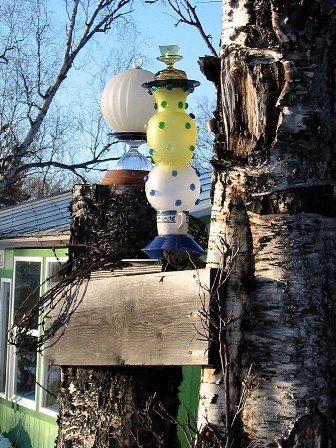DD One
There’s nothing like the cold shock of that first contact with an outhouse toilet seat at twenty below to make one’s mind turn to gardening! The thing is, if your mind is not in its ‘happy place’ it could be a different experience altogether.
I don’t suppose one should admit that they use an outdoor privy, but sometimes that’s the way it goes. We live in my grandmoth
 er’s home – it is small, with plumbing designed for one little old lady. The septic moans and protests on a regular basis as it struggles to keep up with four times its designed load. The result is a periodic revolt, usually in the middle of the winter when the temperatures are the least outhouse friendly. It is during these times that we are blessed with the walk to the outhouse.
er’s home – it is small, with plumbing designed for one little old lady. The septic moans and protests on a regular basis as it struggles to keep up with four times its designed load. The result is a periodic revolt, usually in the middle of the winter when the temperatures are the least outhouse friendly. It is during these times that we are blessed with the walk to the outhouse.The facility is located on a ridge behind the house, and the walk takes several minutes. The path goes up a small hill, across a little clearing and into a small forest. Here it winds a bit as it dips down then up another small incline to its final goal. This miniature forest is my favorite spot on our property. The trees are tall and well spaced, the under story lovely. It’s not a man-made garden, but a garden none-the-less - naturescaping at its best.
Mixed with the Birch (Betula papyrifera Var.humilis) and Spruce (Picea glauca) are two members of the Populus family: White Poplar (Populus balsamifera) and Black Cottonwood (Populus trichocarpa). From the pr
 ivy door the odd Mt. Ash (Sorbus sitchensis) can be seen, though their berries have long been striped by Grosbeaks and marauding Bohemian Waxwings. Under the heavy snow fall I can just make out various shrubs: High Bush Cranberry (Vivernum edule), Labrador Tea (Ledum groenlandicum), Prickly Rose (Rosa acicularis) and an occational Red Osier Dogwood (Cornus stolonifera). Out of my view, just over the edge of the hill I know there is a beautiful stand of Devils Club (Echinopanax horridus). It is magnificent in the spring as the giant leaf buds pop out of the bare prickly stems, changing them from gruesome into something glorious almost overnight. Later when the thicket has become impermeable, the red berries glow against the huge leaves, contrasting with the rest of the woods in their tropical beauty.
ivy door the odd Mt. Ash (Sorbus sitchensis) can be seen, though their berries have long been striped by Grosbeaks and marauding Bohemian Waxwings. Under the heavy snow fall I can just make out various shrubs: High Bush Cranberry (Vivernum edule), Labrador Tea (Ledum groenlandicum), Prickly Rose (Rosa acicularis) and an occational Red Osier Dogwood (Cornus stolonifera). Out of my view, just over the edge of the hill I know there is a beautiful stand of Devils Club (Echinopanax horridus). It is magnificent in the spring as the giant leaf buds pop out of the bare prickly stems, changing them from gruesome into something glorious almost overnight. Later when the thicket has become impermeable, the red berries glow against the huge leaves, contrasting with the rest of the woods in their tropical beauty.Although I can’t see them, I know the snow conceals Red Currant (Ribes triste) and a pallet of mosses, lichens and evergreen Lingenberry (Vaccinium vitis idaea). Further down, dormant now beneath the ground, are perennial plants such as Twin Flower (Linnaea borealis), Monkshood (Aconitum delphinifolium), Bluebells (Mertensia paniculata), Alaskan Violet (Viola langsdorfi), Cranesbill (Geranium erianthum), Baneberry (Actaea rubra), Angelica (Angelica genuflexa), Creeping Bedstraw (Galium triflorum), Ground Dogwood (Cornus Canadensis), Watermelon Berry (Streptopus amplexifolius), Oak Fern (Gymnocarpium dryopteris) and the semi-evergreen Timberberry (Geocaulon lividum) and Wintergreen (Pyrola asarifolia).
The path just outside the door follows downward through a thick patch of Club Moss (Lycopdium annotinum) as it works its way between trees, its bright arms poking out here and there as a reminder of its evergreen tenacity.
Why all this outhouse drivel? I receive frequent questions about Naturescaping. "How do you design natural plantings, how do you choose your plants, how do you know what likes to grow where, what wants tending, what doesn’t?” The answer is simple. I visit the outhouse.
The answer is also complex. To get it right you need to study the directions of the sun, the wind, the snow buildup, the drainage, and the moss growing on the trees. You need to notice when things bloom, when they fruit, when mushrooms emerge and when they melt into piles of slime filling the woods with their own distinctive musky odor. You need to be aware of details such as what grows next to what, which moss is happy on decayed wood and which is happy on stone. What embraces traffic and what shrinks from it? Observe th
 rough an entire year of seasons; take notes, and photos. And if you’re really serious about a natural garden, give me a call. I’ll let you visit the little house. I promise you won’t be disappointed. Don’t forget to check out the Outhouse Garden photos in the album to the right! Enjoy!
rough an entire year of seasons; take notes, and photos. And if you’re really serious about a natural garden, give me a call. I’ll let you visit the little house. I promise you won’t be disappointed. Don’t forget to check out the Outhouse Garden photos in the album to the right! Enjoy!



No comments:
Post a Comment